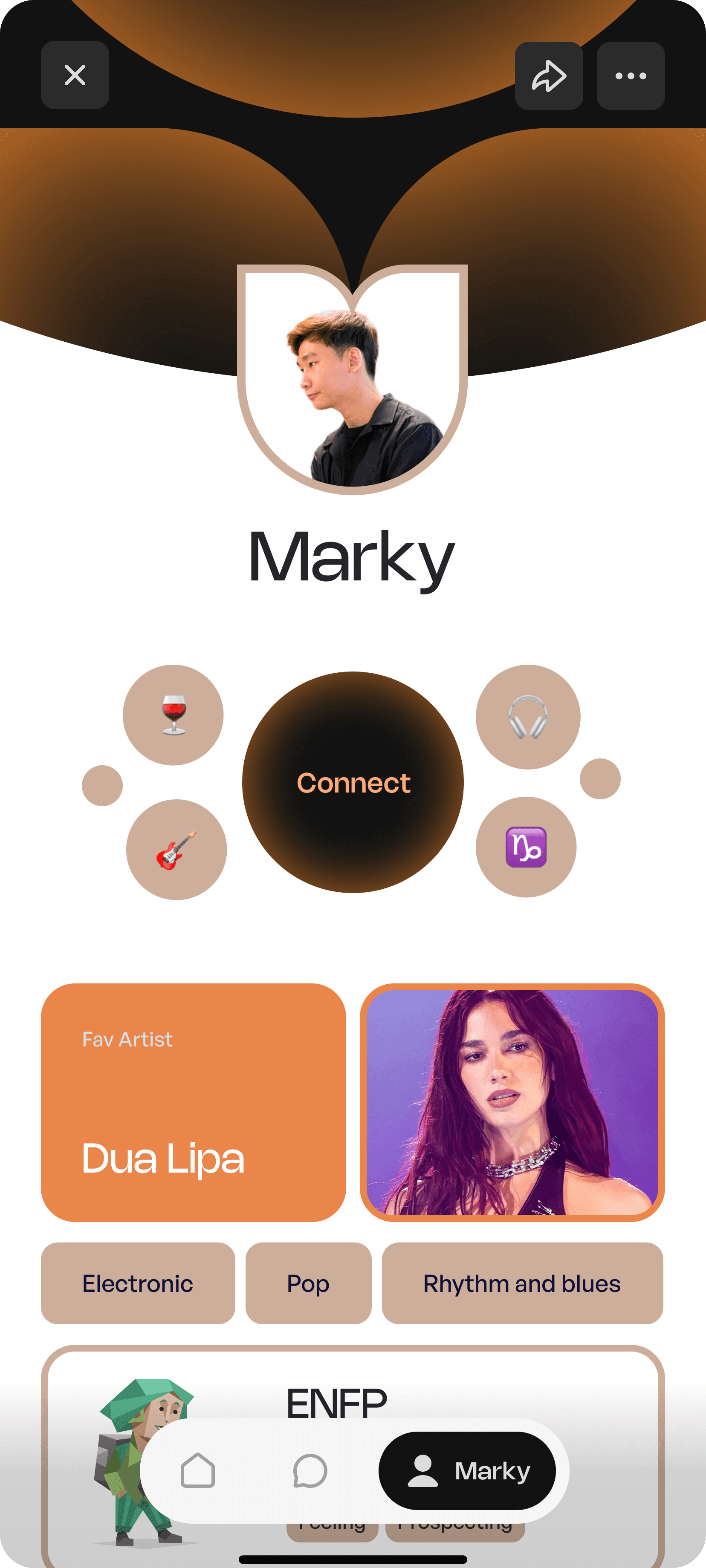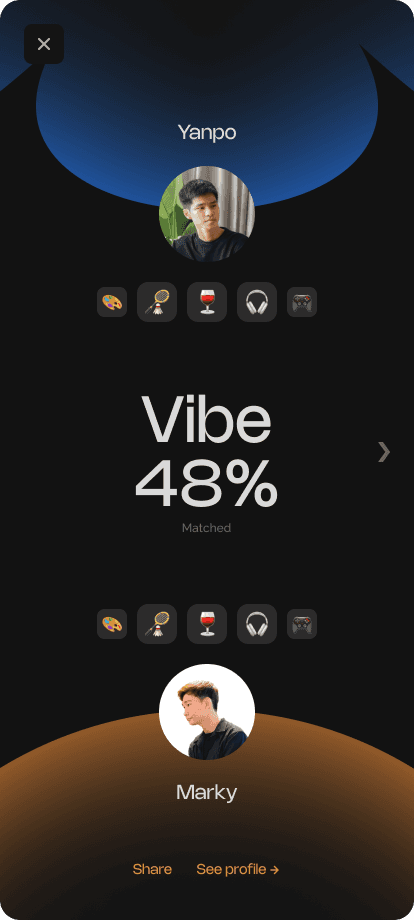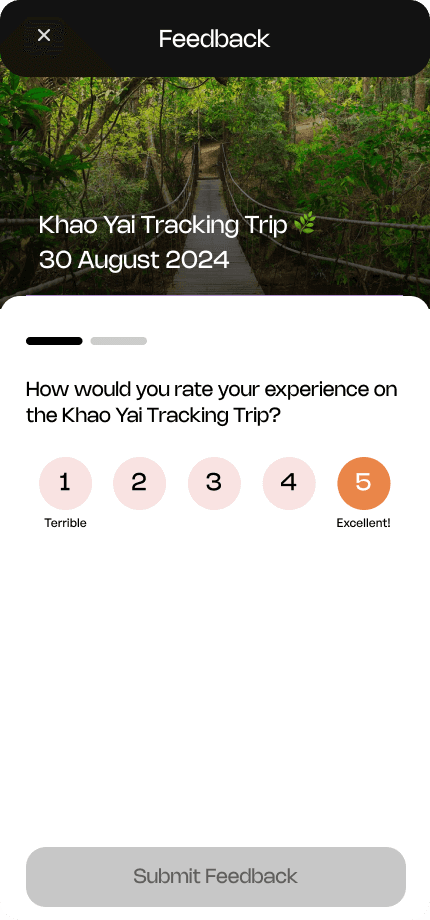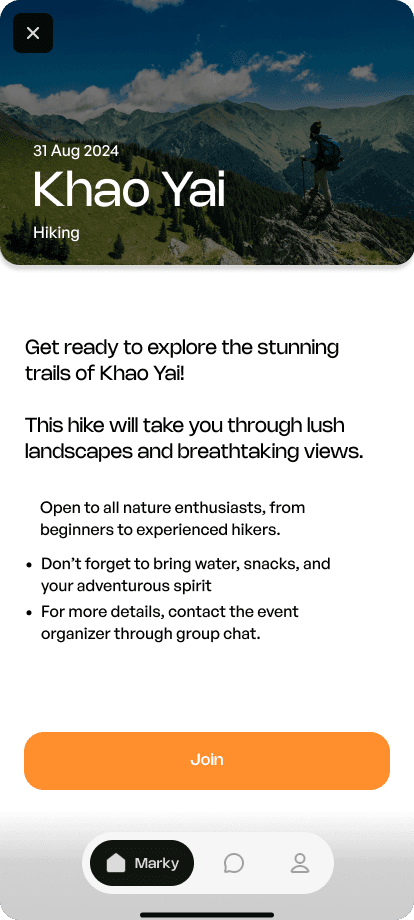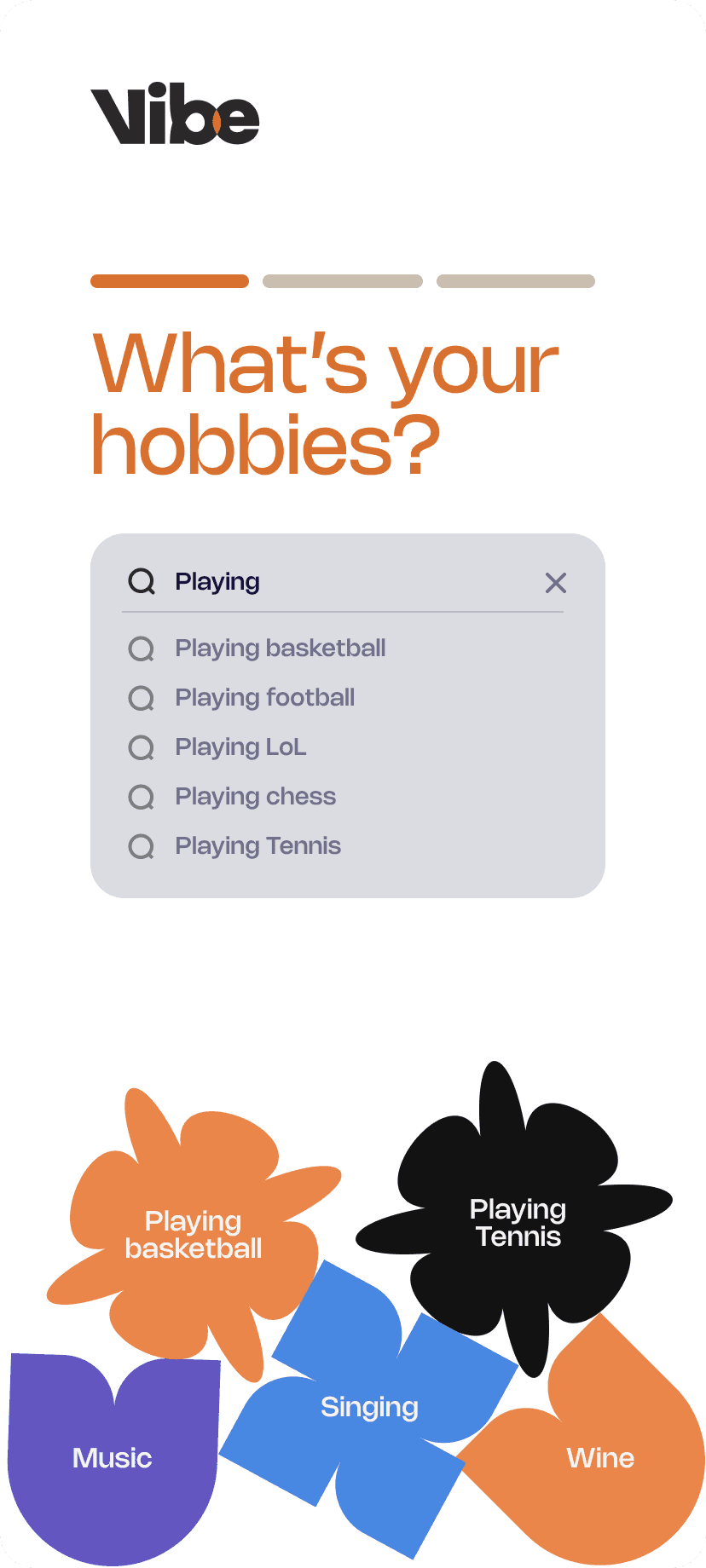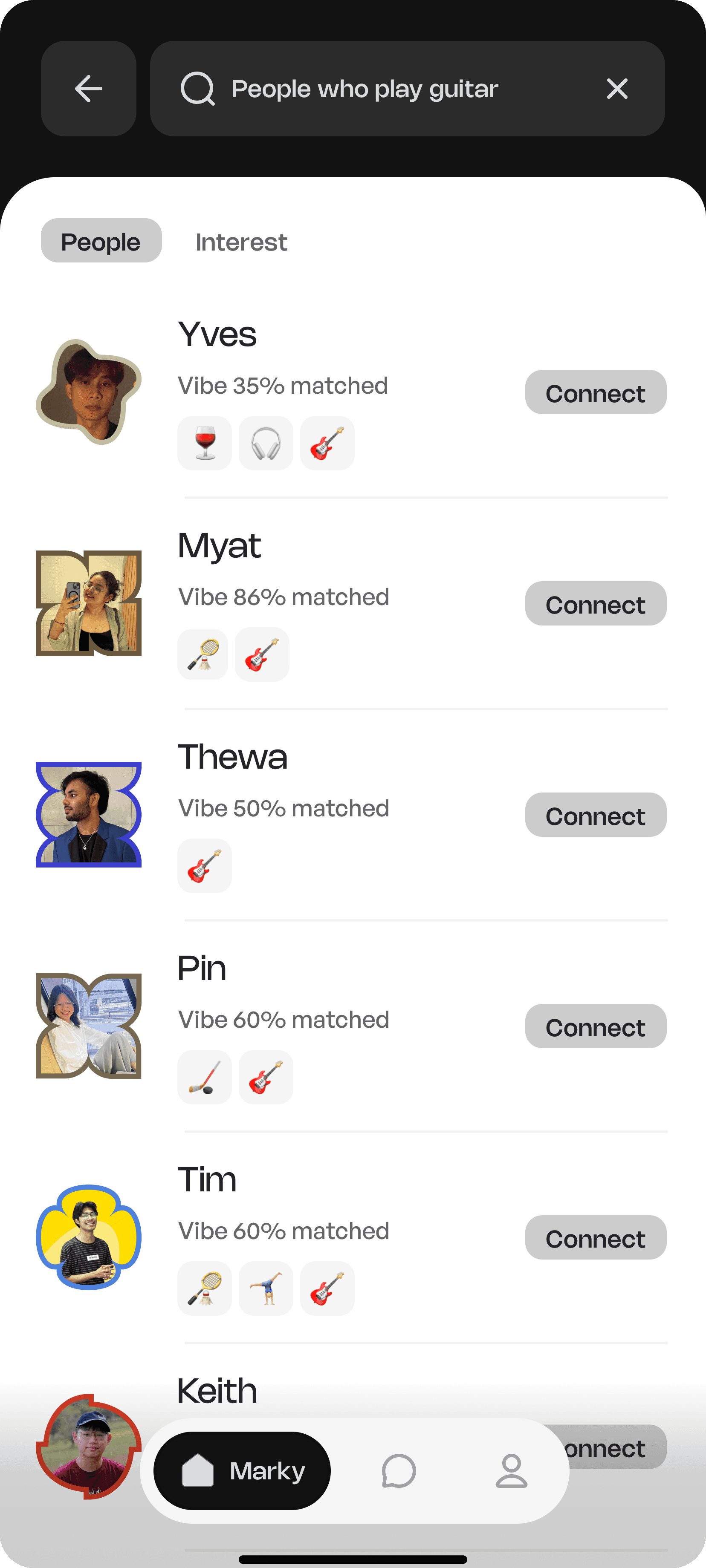
Vibes
Helping students find like minded peers, and help school organize the right events and activities to foster a more connected school community.
Duration
3 weeks
Responsibilities
UX research
UI design
Cross team communicator
Overview
Established in 2015, Harbour.Space University, a small institute with limited staffs, faces challenges in tracking student needs and organizing events to foster engagement and build a tightly connected campus community.
I led the UX research, and prototype testing phase which plays an important role determining the MVPs of Vibe as well as contributing to the dashboard design of Vibe.
MVP #1
Vibe Creations
Students can create their "Vibes" profile based on their personalities and lifestyles.
MVP #2
Finding Similar Vibes
Vibe help suggest students on campus with similar Vibes for potential connection.
MVP #3
Vibe Matching
Matching students with similar Vibes to encourage friendship, and improve campus experiences.
MVP #4
School activities that matches your Vibes
Students receive personalized event and club recommendations based on their Vibes, helping them connect with like-minded peers and enhance their school experience.
MVP #5
Students' Engagement Dashboard
The school collects "Students' Vibes" data for AI to suggest activities that match student interests and track engagement levels.
The reason behind Vibe…
Harbour.space is seeking ways to improve engagement within the students community
The Ask
With students from diverse backgrounds, Harbour.Space faces challenges in creating events that satisfy everyone and foster connections. After discussions, their team outlined key goals for our design at the project's start.
Taking a look at the current tools that universities uses
No platform tracks, manages, and analyzes student personalities and vibes while helping schools organize events to enhance social connections.
Market Research
SWOT Analysis of the current school management softwires
Market research reveals a gap in software tailored to students' personalities and preferences, highlighting the need for tools that prioritize community and connection building over academic management.

Strength
Strong integration with Google tools and extensive usage in educational settings.
Robust collaboration features and compatibility with Microsoft’s ecosystem.
Comprehensive academic management features with strong reporting tools.
Weakness
Limited focus on non-academic social interaction.
Overly formal interface lacks appeal for casual or community-driven interactions.
High cost and lack of emphasis on fostering interpersonal connections.
Opportunity
Potential to expand beyond academic tools to support student connection-building.
Adding features that enable informal networking and personalized student connections.
Expanding to offer tools that enhance peer networking and social engagement.
Threats
Emerging platforms like Vibe addressing the social and community needs of students.
Competitors offering student-focused solutions for non-academic experiences.
Affordable platforms addressing student-centric, non-academic needs.
Conducting a quick round of primary research…
We interviewed staffs, and students to try to pinpoint the pain points of both parties
Users Research
Interviews and Data Synthesis
Upon the initial exploration research into Harbour.space communities, we tried to use the data from the interviews to conclude and shape our main problem insights.
4
Harbour.space staffs
5
Current Harbour.space students
2
Student committee member
3
Educational administrators
University Pain Point:
Track Students' Interests, Boost Engagement
Harbour.space lacks data in terms of the students' personalities, and struggle to come up with campus events, leading to low students engagement.
Student Pain Point #1
Difficulty Connecting with Peers
Harbour.space new and current students find it hard to break the ice and make friends.
Student Pain Point #2
Discovering Relevant Clubs and Events
Harbour.space foreign and Thai students has limited access to events, and clubs info's
Personas
International Student Iris
"I want to make new friends, but it is so hard to relate to the activities on campus, what they usually organize is not for me"
Iris just recently moved to Thailand to attend Harbour.space, due to the language barrier and introverted personality, she finds it hard to find like-minded peers and make new friends on campus
Pain Points
Workarounds
Struggles to find like-minded peers and build a supportive social network in a new environment.
Try to use social media and the classroom to make new friends
Challenges in navigating through multiple social media pages, word of mouths and posters to find clubs and events that is right for her
Try to talk to classmates to find after school activities and look through the school board
Trouble finding resources, support services, and understanding administrative processes as an international student.
Use university portals to find information and resources
"I need a way to truly understand my students—beyond just grades—so I can help them connect, engage, and thrive on campus."

Christ's main responsibilities include creating a vibrant and inclusive campus, filled with activities and strong bonded communities and relationships in order to raise the quality of campus life for students.
Pain Points
Workarounds
Difficulty in motivating students to participate in extracurricular activities and fostering connections.
Use surveys and event listing announcements on the schools main communication channel
Reliance on basic academic data with no access to students’ interests or social preferences for personalized engagement.
Uses feedback forms and causal conversions with the students to build relationships to understand the students better
Struggles to create a supportive and inclusive environment due to diverse student needs.
Attempt to create multiple events and clubs to foster communities

How might we help Harbour.Space students make new friends and engage more in campus activities?
Ideation
Wireframing
By combining the industry insights, and user pain points, we brainstormed MVPs and visualized them into low fidelity wireframes!
Delivery
Introducing Vibe
Vibes is a software and mobile application that allows students to create their "Vibes" and suggest campus activities and communities that match their interests, enabling them to find fellow students with similar personalities. Simultaneously, the university collects and analyzes these "Vibe" data to design more targeted events and activities, ultimately fostering a more engaged and closely connected campus community.
Start
The students register and create their vibe profile
Find
Get notified on personalized school events and activities that matches their "Vibes"
Join & Feedback
The students can register for the events, and give feedback on their experiences
Match Vibes
The students can find other students who has similiar vibes, and connect them over the events
University's side
Participations data & AI suggestions
The "Vibe Profile" collects data to suggest events for universities, provide insights on student preferences, and analyze feedback from past events.
Testing & Result
Prototype Testing Plan
5
Harbour.space students
2
Harbour.space staffs
The prototype of the app was given to the students, and they were tasked to create a profile, and find activities on campus that match with their "Vibes" as well as connect with others of similar vibes. After the task, Interviews, SUS and NPS surveys were conducted. We also presented the concept to the school staffs to get feedbacks as well.
A snapshot of the overall testing insights
Great usability, but a low NPS score raises concerns about its impact on students
Overall Interview Feedback:
Centralized Information
Students saw the importance of the app being a central place to find events info
SUS Score Result:
75
Indicates good usability but room for improvement
NPS Score Result
32
students are unsure if the app is different from normal social medias
Key interview findings & Actionable Insights
Some of the most frequently mentioned issues in the interviews includes:
1
A great platform for non-academic data—but how do we measure and define "Vibes"?
2
Unsure if Vibes can be integrated into academic management platforms
3
Students does not see Vibe as different from Facebooks, Instagram or even Tinder
Next Step #1
Define Vibe Metrics
Defining measurable data metrics in the vibes creation feature of the students that are useful for event plannings and matching
Next Step #2
Vibe classroom integration
Exploring integration features into the current classroom management software instead of "adding another unused school app" to the list
Next Step #3
Vibe social
Focusing on differentiating and providing more unique value to the students
Key Learnings
Self Reflection
Since this is only the "Design" part of the project, there is the other half of the team members doing the "Business" of Vibes as well, therefore, as a design manager, I learnt to be collaborative, always over-communicating but not over pushing, ensuring both sides are connected, and be on the same page throughout the project.
The Team
A shoutout to my teammates from the Vibe team in class who worked really hard in ensuring the project ended really successfully. This project was a part of a 3 weeks course called "From Zero to Hero" at Harbour.space. I am grateful to Marky, Thewa, Myat, Keith, Yanpo, Thuta and Pin for contributing to the project and Mr. Kamran for guiding us through the course.




